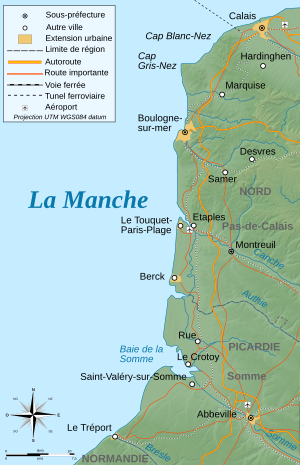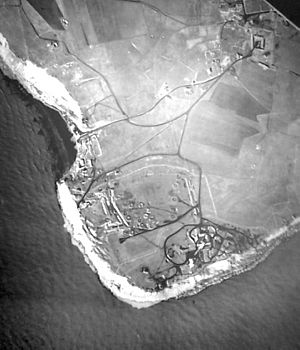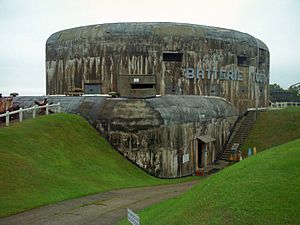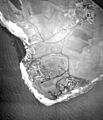Operation Undergo facts for kids
Quick facts for kids Operation Undergo (Siege of Calais) |
|||||||
|---|---|---|---|---|---|---|---|
| Part of Western Front of the Second World War | |||||||
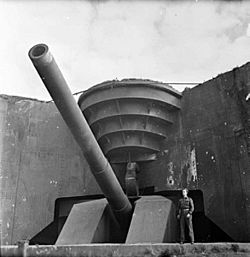 A British soldier poses next to the recently captured German 380 mm gun Todt Battery at Cap Gris Nez. |
|||||||
|
|||||||
| Belligerents | |||||||
| Commanders and leaders | |||||||
| Strength | |||||||
| unknown | 7,500 Calais |
||||||
| Casualties and losses | |||||||
| 260 killed or wounded German shelling of Dover: 5 military personnel 16 civilians |
9,128 captured incl. 1,600 from Cap Gris Nez |
||||||
Operation Undergo was a military attack by Canadian soldiers on the German forces in the French port city of Calais in September 1944. This operation also included capturing powerful German long-range guns at Cap Gris Nez. These guns were a threat to ships heading to Boulogne.
This attack was part of a bigger plan called the Clearing the Channel Coast. The First Canadian Army carried out this plan after the success of Operation Overlord and the Allied forces breaking out of Normandy. The attack on Calais used similar methods to Operation Wellhit in Boulogne. First, the city was surrounded. Then, there were heavy bombardments from land, sea, and air. After that, soldiers attacked, supported by tanks that could shoot flames and continuous artillery fire.
Calais had been declared a "fortress" by the Germans. However, the German soldiers there were not very strong. They did not need much convincing to give up. The same happened at Cap Gris Nez. Canadian soldiers attacked Calais from the south-west and cleared the first German defenses. Then, they attacked the inner defenses from both sides. The Germans asked for a truce, which led to their complete surrender. At the same time, Canadian soldiers captured the heavy gun batteries at Cap Gris Nez.
Contents
Why the Allies Attacked Calais
The Allied Push Forward
After a major defeat at Falaise, all German forces in northern France started to retreat. They had no strong defenses to fall back on because Adolf Hitler had forbidden building them. The Allied armies moved very quickly into eastern France and through Belgium. This fast advance meant their supply lines became very long.
General Bernard Montgomery decided that the First Canadian Army needed to capture important ports to bring in supplies. These ports included Le Havre, Dieppe, Boulogne, Calais, and Dunkirk. Most of these ports had been heavily fortified by the Germans. The German plan was to hold onto them for as long as possible.
After surrendering, the German commander, Ludwig Schroeder, described his 7,500 soldiers as "mere rubbish." Only about 2,500 of them were fit to fight as infantry. Many were "ethnic Germans" born in other countries or foreign volunteers. Their morale was low, and they were easily influenced by Allied messages. Schroeder himself was seen as a "mediocre" leader who became commander by chance.
The Land Around Calais
The French coast near Calais runs northwards from Boulogne. It then turns sharply at Cap Gris Nez. There are no big natural harbors, but important docks were built in the low-lying land at Calais. The area around Cap Gris Nez and Cap Blanc Nez is hilly. Calais itself is on the edge of a flat plain with rivers and canals.
Calais had been a fortified city for hundreds of years. The British and French used its defenses in the siege of Calais in 1940. After 1940, the Germans added to these defenses as part of their Atlantic Wall system. By 1944, the Germans had 42 heavy guns near Calais. These included five batteries of cross-channel guns. Some of these were the huge 406 mm guns at Sangatte and 380 mm guns at Batterie Todt. The Germans had also flooded the land and added lots of barbed wire, minefields, and bunkers.
Planning the Attack
The Allies knew it was vital to silence the German heavy guns around Calais. These guns could threaten ships going to Boulogne and even shell Dover in England. General Daniel Spry planned an attack similar to the one used for Boulogne.
First, there would be a massive bombardment from land, sea, and air. This was meant to weaken the German defenses and lower their will to fight. After that, soldiers would attack. They would be supported by special tanks like the Churchill Crocodile (which shot flames) and Wasp vehicles. These were used to "persuade" the defenders to surrender. Kangaroo armored vehicles would carry soldiers as close as possible to their targets.
The plan was to attack Calais from the west and south-west. This avoided the worst flooded areas and the main city. One Canadian brigade would attack positions near Cap Blanc Nez. Another brigade would attack garrisons closer to Calais. A third brigade would prepare to capture the big guns at Cap Gris Nez.
General Montgomery wanted the port of Antwerp opened quickly. He told General Harry Crerar to capture the Channel Ports fast. Crerar realized how much effort was needed for these ports. He was ready to just surround Calais and move troops to Antwerp, which was a more important port. However, this message did not reach General Spry, who continued with the attack on Calais.
The Battle Begins
Capturing Wissant
The 7th Canadian Brigade had already surrounded Calais in early September. The Regina Rifles captured the coastal town of Wissant. This cut off the Cap Gris Nez gun batteries from Calais. They also took over the German gun battery at Wissant. This success made General Spry try to attack Cap Gris Nez with two battalions, but this first attempt failed. The area was left for a later attack.
The Fight for Calais
The main attack on Calais began at 10:15 a.m. on September 25. This was after a day's delay and heavy bombing from planes and artillery. Canadian soldiers advanced through Escalles, taking Cap Blanc Nez. This proved surprisingly easy, as the German soldiers surrendered quickly.
Another Canadian regiment attacked the fortified Noires Mottes. This attack was supported by special tanks that could clear mines and flame-throwing tanks. Some German soldiers tried to surrender but were shot by their own side. The advance was difficult due to craters and strong German defenses. However, after talks with German prisoners, the Noires Mottes garrison surrendered the next morning, September 26. This was a big victory, capturing a strong position and nearly 300 prisoners. The Sangatte battery also surrendered.
The early success helped the other Canadian brigades attacking Calais. They advanced through fortifications and reached the seafront. Even though the bombardments missed some targets, the Canadians, with the help of flame-throwing tanks, overcame the defenders. By the morning of September 26, the Canadian brigades had completed their objectives. One brigade was then moved to the eastern side of Calais to put pressure on the Germans from another direction.
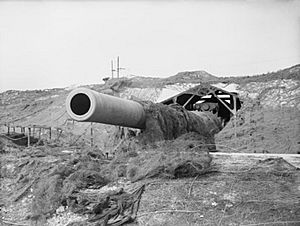
The next steps involved advancing through flooded ground and attacking Fort Nieulay. Soldiers also made a frontal attack on Calais, even using boats to cross flooded areas. These advances were tough, and the Germans fought hard. Fort Lapin fell only after more air attacks and tank support. Other Canadian units, again helped by flame-throwing tanks, captured Fort Nieulay and reached the factory district.
More advances were made on September 28. Two Canadian companies crossed a canal but were then trapped. They remained cut off until a truce was called. The German commander, Schroeder, asked for Calais to be declared an "open city" (meaning no fighting would happen there). This was rejected as a delaying tactic. However, a truce was agreed upon for September 29 to allow 20,000 civilians to leave safely.
The Canadians attacked immediately after the truce ended on September 30, even though some Germans tried to surrender. Schroeder had ordered his soldiers to stop fighting. Canadian troops entering from the west met no resistance, as German soldiers surrendered everywhere. A Canadian officer, Lt Colonel P. C. Klaehn, bravely entered Calais during an artillery bombardment to accept the official surrender. Schroeder became a prisoner at 7:00 p.m.
Taking Cap Gris Nez
An earlier attempt to take Cap Gris Nez in mid-September had failed. So, the 9th Canadian Brigade was sent there with strong tank support. Their mission was to capture the three remaining heavy German gun batteries. These batteries were protected by minefields, barbed wire, bunkers, and anti-tank positions.
Before the infantry attack, over 800 planes from the RAF Bomber Command bombed the area. This likely weakened the defenses and the German soldiers' will to fight. However, the bomb craters made it hard for tanks to move. British heavy guns in Dover, named Winnie and Pooh, also fired accurately and disabled one of the German batteries.
On September 29, artillery opened fire at 6:35 a.m., and the infantry attack began ten minutes later. The Canadians advanced behind a "creeping barrage" of artillery fire, which kept the Germans hidden. The Germans surrendered quickly once the Canadians reached them. One battery was captured in less than three hours. Another was taken that afternoon.
The Canadian soldiers faced even less resistance at the third battery. They reached the gun houses without opposition. The concrete walls were too strong for some of their weapons, but the noise and shock of explosions, along with grenades thrown into openings, made the German gunners surrender. The Canadians then captured the local German headquarters. Despite the impressive German defenses, the defenders refused to fight on. The operation was completed with relatively few casualties.
What Happened Next
The port of Calais was severely damaged. It could not be used until November, after the port of Antwerp had been opened. Even then, only people could use it, not supplies. Capturing the German heavy guns at Cap Gris Nez allowed ships to use Boulogne. Mine-clearing began just hours after the Canadian victory.
The capture of these German guns ended four years of artillery exchanges across the English Channel. From September 23 to 26, Dover was hit by the last German artillery barrage. Five soldiers and 16 civilians were killed. To mark the end of the shelling, the mayor of Dover was sent a German flag from the captured batteries.
Some people criticized the Canadian forces for their speed at Calais and other Channel ports. Their progress was sometimes compared negatively to other Allied units. General Montgomery even said the Canadian Army was "badly handled and very slow." There was speculation that the Canadian commander, Crerar, left due to illness, but it might have been a way to remove him from command. His replacement, Guy Simonds, was much preferred by Montgomery. Simonds then commanded the forces that cleared the way to Antwerp.
Images for kids
-
Winnie – a British 14-inch gun at St Margaret's at Cliffe near Dover


